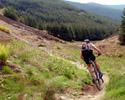
Recently on Cyclingnews.com |
 |
Test to destruction: The Keith Bontrager diary 2007
Keith Bontrager is best known as the bike and component design guru behind his eponymous road and mountain bike components, but behind the scenes, the man universally known as KB is an enthusiastic and well-respected endurance mountain bike racer.
KB has taken part in a over 50 24-hour races in the last few years, and in his diary takes us inside the mental, physical, and technical challenges of long-distance mountain bike racing while juggling the demands of an active interest in the successful international business he began all those years ago.
June 6, 2007
TransScotland final wrap
The last stage was not the typical short party stage that these races often end with. There was no big hurry to finish, but it was a long route with some big climbs so it wasn't going to be easy.
I'll avoid dragging you through the repetitive descriptions that I have fallen into. It was a good day, with a lot of fine singletrack, amazing views, good weather and very little time off the bike. The only bad thing that I came across was a very surly horsefly that smashed into my jaw within a few km from the finish. It nipped me somehow and now my jaw looks like I got punched. How can a fly bash into you like that and still find a way to bite you at the same time?
There was no change in the GC. I ended up 9th. I'll take it.
The Race

|
I really enjoyed this race. The quality singletrack and the TT scoring format are really fun. There is more good singletrack in this route than in any other Trans-XXX race by far, maybe a factor of 10 or more. That definitely makes for a better race for me. At this point I am pretty sure I'll be back for more.
Some of these events start off on the notion that they have to go from here to there, in a more or less straight line. The TransAlp goes south from Germany to Italy. The Cape Epic crosses the cape. That's a fine idea and it works well in some cases, especially the Alps. But in some cases connecting the start and finish towns with interesting race routes every day is not too easy to do. You can end up with some very long stages that could be done on a road bike. That's also not that bad if you are into it, and I can usually work it out. But it is not the same as racing on a fair amount of sweet singletrack everyday.
So why not develop stage races that optimize the quality of the course rather than going from here to there? Loop it around as required to make each day hard, but a good MTB race. Don't call it Trans-XXX. Call it the MTB Tour of XXX or 7 days of XXX. You get the idea.
You could even base the entire race in one spot and have the course go off in a different direction each day, along the lines of Montezuma's Revenge, but over a week instead of in one seriously insane day. Mix in time trials, hill climbs, down hill TTs, etc. This would not be possible everywhere, but there are spots in many places where it would be possible. I can rattle off ideal locations in the Alps, Dolomites and in the States where it could work. (These comments are here for a small audience - you know who you are and I know you are reading this...)
The logistics of running this sort of event would be much simpler. Riders could be more comfortable - you are coming back to the same place each day so the ritual packing and unpacking of bags goes away. Riders would have better support - they could have spares and tools on hand. They would eat better - food prep could be done in a more organized way because it doesn't have to be portable.
Food is something that is often not given the treatment it deserves in these races. I might be putting a little too much thought into this given the amount of cooking I do, but after riding all day a good meal is a very important thing. The same goes for what is offered at the food hand ups along the route. So far the Cape Epic has won the most stars in its approach to food, followed closely by the Super Travessia in Portugal.

|
Some more technicalities for anyone interested in racing one of these:
My bike worked pretty well the entire race. I had a few small issues along the way, which is common in these because of the mud and unknowables along the route. I started with a fresh bike, mostly new drive train parts and brake pads, tight wheels and new tires. The rest of the bike had some miles on it and was sorted out well.
There were a lot of mechanicals that cost people, either directly in the TTs or indirectly because the repair made them have to ride hard to make up time in the linking stages. Here's my two cents on how to avoid this sort of thing.
Maintain your bike's drive train every day and along the stage occasionally too.
Clean the chain, cogs and derailleurs well after the stage, and then oil everything. Wipe the excess oil off after it has penetrated well, then re-oil the chain. Wipe the excess off again an hour afterwards.
Use oil that is suitable for the conditions - a heavy oil on muddy days and a lighter oil in dusty conditions. Take a small bottle of oil with you and give the chain a quick dose late in the stage when it is dry.
You are much more likely to break a chain when the shifting starts to deteriorate. Simple maintenance helps prevent this.
Carry a SRAM Powerlink in your tool bag and make sure you know how to use it. This is the fastest way to repair a broken chain on the trail that I am aware of. It is compatible with Shimano chains too.

|
Seal the rear shifter cable before the event. This is a trick you can do with ferrules and shift cable inner liner and it is fiddly, but not expensive or difficult to do. Once sealed properly the rear shifting will be much more consistent and require much less maintenance time between stages. This is also another way to prevent chain failures. The chain is much less likely to break when the bike is shifting properly.
Ride smart. If you have to run or walk a technical section, either up or down, to avoid breaking your bike or yourself, do it. Don't force shifts. These are long races, and gaining a second here or there is not high a priority if it involves excessive risk. A single mechanical will cost you a lot more time than you can make up riding over your head. The key is to be smooth and fast.
And, lastly, my favorite, with an obvious bias, but not an unreasonable one - use a tire set up that works for the conditions and that is durable.
There were a lot of punctures in this race, and many (most!) of those were probably unnecessary. I typically deliver this message regularly during the race, in the gentlest way possible of course. Typically it goes something like this (while smiling): "I could give you my full sales pitch for tubeless tires that don't pinch flat with sealant that repairs thorn punctures now, but I won't". The message is clear enough.
Tubeless tires with sealant are the best way to deal with this. The tubeless set up is very resistant to pinch flats, and the sealant will deal with thorn and glass punctures on the fly. I do not end up stopping often to make a repair during a race. That matters to me. They really do work. There are plenty of options for you to set wheels up this way, some home made that cost next to nothing if you are clever. I won't make any specific brand recommendations, though I could.
I used an ACX 2.2 tubeless tire front and rear in this event. These are a Swiss Army Knife tire, reasonably good in a lot of conditions including mud and loose rock, but not too bumpy and slow on pavement. There were stages where I could have benefited from a smoother, faster tire. But I didn't know the course or what the weather was going to be so it would have been a gamble to use a faster tire. I think they worked out fairly well overall. (I shamelessly snuck a spare set of wheels set up with mud tires into a journalist's van too, but never used them. The weather in Scotland was a little too good...)
I started with relatively high pressure in them, around 35 psi. As the race went on and I became more familiar with the conditions I dropped that pressure. On some of the stages I rode with 28 psi in the tires. They worked better on all but the paved sections at lower pressure. They were much better than tires inflated to higher pressure on wet roots and rocks. There is no comparison really. Good tires set up with the right pressure make you a better rider.
I use twice the normal volume of sealant in my tires for this sort of race too. There is a very small performance cost, much less than the time cost of repairing one puncture.
The typical resistance to setting up wheels like this is, in my opinion, weak - it's too fiddly, too much hassle, I tried it once but it didn't work out. How much hassle is it to mend a puncture in the mud, in a lashing rain, 10 km from the finish line, watching the competitors you busted your ass to pass streaming back past you? That might be a bit dramatic, but you get the idea. A little extra work beforehand to prevent a failure on the course is well worth it.
I'll try to illustrate this with an example. The concept applies to a lot more than tires and tubes. Sometimes working through a bit of complexity and mastering it is a worthwhile thing to do. Not everything in your life needs to be easy. This race wasn't easy!
I have an espresso maker, a Ranchilio Silvia. It is a manual machine, not very expensive, built like a brick. There are no bells and whistles. If you don't know how to use it, you get bad coffee. I could have bought an automatic device, one that requires no more than putting the beans and water in the proper places. Then I would have not had to deal with any complexity. But I didn't want to do that. It took me a few weeks to figure out Ms. Silvia's quirks and I suffered through a few weak cups of coffee. But in the end I figured it out. Now I can make good coffee every time because I know how the machine works, and how espresso is made. It took some time and effort, but it was worth it. I learned a skill and my life is better for it.
It might take you a few tries to figure out how to deal with the quirks of tubeless tires. When you do, you will have fewer flats. And you will be able to run lower pressure in your tires when you want to, and you will be quicker in some difficult conditions because you do.
Enough.
The Twentyfour/12 comes up next for me. If you haven't entered, do. It's going to be a good one.
KB.
